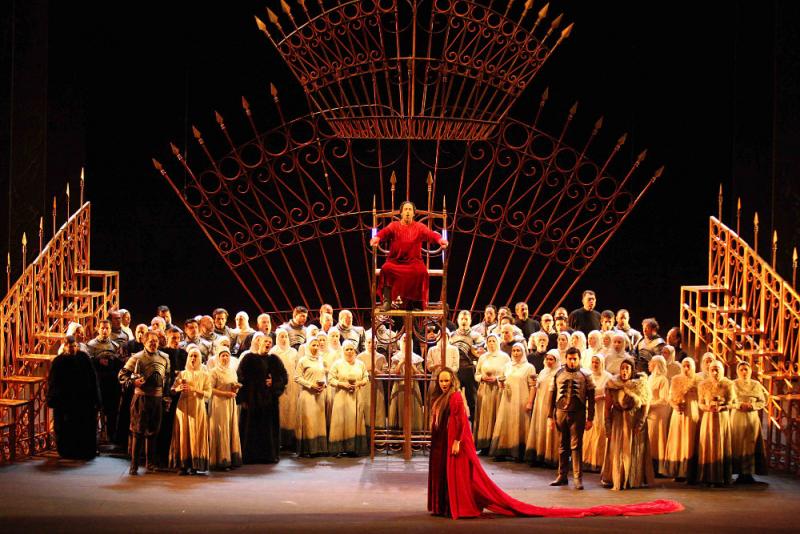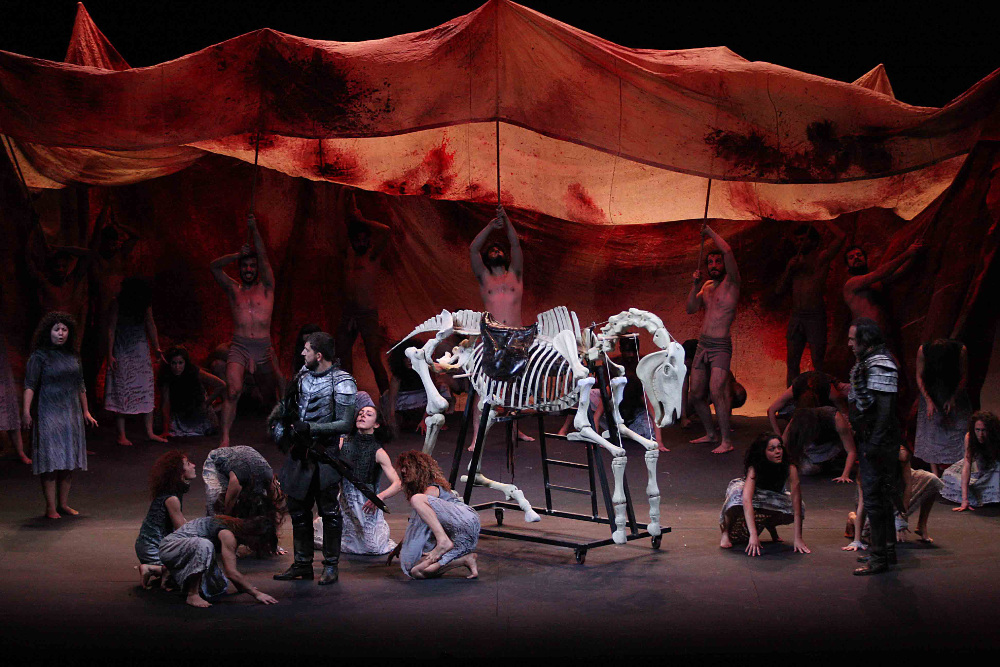Edinburgh Festival 2017 review: Verdi's Macbeth - exhilarating and overwhelming | reviews, news & interviews
Edinburgh Festival 2017 review: Verdi's Macbeth - exhilarating and overwhelming
Edinburgh Festival 2017 review: Verdi's Macbeth - exhilarating and overwhelming
Visually dazzling, musically robust though not always conventionally coherent

Skeletal horses; piles of newborn babies smothered in a bloody sheet; a whole garden centre of prickly pears. There’s no denying that Italian director Emma Dante’s new production of Verdi’s Macbeth, which Turin’s Teatro Regio brings to the Edinburgh International Festival, is visually dazzling, even at times hallucinatory.
There’s a nagging concern, however, about what all the visual flamboyance actually adds up to – those perpetually procreating witches, seemingly modelled on the long-haired ghoul from Japanese horror film Ring; the imposing crown-formed decors; the circus fire eaters and acrobats heralding the arrival of King Duncan.
Rather than combining together in a singular perspective on Verdi’s dark Shakespeare adaptation, this Macbeth feels like Dante’s deeply personal response, driven seemingly by her own personal mythology. If it doesn’t always make sense, it’s a thrilling ride nonetheless.
Back in 1947, it was Glyndebourne that brought Macbeth – the International Festival’s first ever staged opera – to Edinburgh. Seventy years later, Macbeth is the first of two productions from Turin’s Teatro Regio, the International Festival’s resident company for 2017, which also stages an opulent La bohème next week and performs Verdi’s Requiem in the Usher Hall.
And it’s hard not to be seduced by the visual splendour of Dante’s production, designed with devil-may-care flair by Carmine Maringola. Their stages are often teeming with hectic activity, alive with movement, the Teatro Regio’s already substantial chorus (put to very good use) joined by actors and a corps de ballet from Palermo to create several memorable images, not least the immense, writhing blood-stained sheet (pictured below) that serves to unify much of the first two acts. Rare episodes when cast members simply stand and sing come as welcome moments of calm and focus in among all the freneticism. Cristian Zucaro’s lighting, too, plays a pivotal role, with figures lurking half-seen in the shadows at the back of the stage. It doesn’t all hit its target. Dante’s recasting of Birnam Wood as a forest of cacti, perhaps drawing on her own Sicilian background, feels faintly ridiculous, as does Lady Macbeth’s elaborate, beautifully choreographed dance with nine self-propelled hospital beds in her sleepwalking scene. But even those images have an unsettling, sometimes uncanny power to them that lodges them in the mind.
It doesn’t all hit its target. Dante’s recasting of Birnam Wood as a forest of cacti, perhaps drawing on her own Sicilian background, feels faintly ridiculous, as does Lady Macbeth’s elaborate, beautifully choreographed dance with nine self-propelled hospital beds in her sleepwalking scene. But even those images have an unsettling, sometimes uncanny power to them that lodges them in the mind.
But if it’s a visually splendid production, then musically it’s just as strong, with a cast of singers all robust and forcefully projected. Marko Mimica is a loyal, big-hearted Banquo, and Gabriele Viviani’s Macbeth treads a fine line between put-upon puppet and angry, ambitious anti-hero, particularly searing in his final death scene, reinstated from Verdi’s original 1847 version. Above all, Oksana Dyka’s Lady Macbeth is a terrifyingly intense creation, unafraid of spitting out her lines or reducing her honeyed tone to a snarl or a howl (it was Verdi, after all, who requested “the voice of a devil” for the role), and commanding both the stage and the opera’s unfolding.
Best of all, however, is conductor Gianandrea Noseda’s miraculous Turin band in the pit. Together they give a vivid, raw, feverishly detailed account of Verdi’s score, one that’s alive with telling meaning. This Macbeth is an exhilarating, overwhelming production – even if it’s one that occasionally dispenses with conventional coherence.
- The Edinburgh International Festival and Fringe continue until 28 August
- Read more classical reviews on theartsdesk
The future of Arts Journalism
You can stop theartsdesk.com closing!
We urgently need financing to survive. Our fundraising drive has thus far raised £49,000 but we need to reach £100,000 or we will be forced to close. Please contribute here: https://gofund.me/c3f6033d
And if you can forward this information to anyone who might assist, we’d be grateful.

Subscribe to theartsdesk.com
Thank you for continuing to read our work on theartsdesk.com. For unlimited access to every article in its entirety, including our archive of more than 15,000 pieces, we're asking for £5 per month or £40 per year. We feel it's a very good deal, and hope you do too.
To take a subscription now simply click here.
And if you're looking for that extra gift for a friend or family member, why not treat them to a theartsdesk.com gift subscription?
more Opera
 BBC Proms: The Marriage of Figaro, Glyndebourne Festival review - merriment and menace
Strong Proms transfer for a robust and affecting show
BBC Proms: The Marriage of Figaro, Glyndebourne Festival review - merriment and menace
Strong Proms transfer for a robust and affecting show
 BBC Proms: Suor Angelica, LSO, Pappano review - earthly passion, heavenly grief
A Sister to remember blesses Puccini's convent tragedy
BBC Proms: Suor Angelica, LSO, Pappano review - earthly passion, heavenly grief
A Sister to remember blesses Puccini's convent tragedy
 Orpheus and Eurydice, Opera Queensland/SCO, Edinburgh International Festival 2025 review - dazzling, but distracting
Eye-popping acrobatics don’t always assist in Gluck’s quest for operatic truth
Orpheus and Eurydice, Opera Queensland/SCO, Edinburgh International Festival 2025 review - dazzling, but distracting
Eye-popping acrobatics don’t always assist in Gluck’s quest for operatic truth
 MARS, Irish National Opera review - silly space oddity with fun stretches
Cast, orchestra and production give Jennifer Walshe’s bold collage their all
MARS, Irish National Opera review - silly space oddity with fun stretches
Cast, orchestra and production give Jennifer Walshe’s bold collage their all
 Káťa Kabanová, Glyndebourne review - emotional concentration in a salle modulable
Janáček superbly done through or in spite of the symbolism
Káťa Kabanová, Glyndebourne review - emotional concentration in a salle modulable
Janáček superbly done through or in spite of the symbolism
 Buxton International Festival 2025 review - a lavish offering of smaller-scale work
Allison Cook stands out in a fascinating integrated double bill of Bernstein and Poulenc
Buxton International Festival 2025 review - a lavish offering of smaller-scale work
Allison Cook stands out in a fascinating integrated double bill of Bernstein and Poulenc
 Tosca, Clonter Opera review - beauty and integrity in miniature
Happy surprises and a convincing interpretation of Puccini for today
Tosca, Clonter Opera review - beauty and integrity in miniature
Happy surprises and a convincing interpretation of Puccini for today
 Hamlet, Buxton International Festival review - how to re-imagine re-imagined Shakespeare
Music comes first in very 19th century, very Romantic, very French operatic creation
Hamlet, Buxton International Festival review - how to re-imagine re-imagined Shakespeare
Music comes first in very 19th century, very Romantic, very French operatic creation
 Falstaff, Glyndebourne review - knockabout and nostalgia in postwar Windsor
A fat knight to remember, and snappy stagecraft, overcome some tedious waits
Falstaff, Glyndebourne review - knockabout and nostalgia in postwar Windsor
A fat knight to remember, and snappy stagecraft, overcome some tedious waits
 Salome, LSO, Pappano, Barbican review - a partnership in a million
Asmik Grigorian is vocal perfection in league with a great conductor and orchestra
Salome, LSO, Pappano, Barbican review - a partnership in a million
Asmik Grigorian is vocal perfection in league with a great conductor and orchestra
 Semele, Royal Opera review - unholy smoke
Style comes and goes in a justifiably dark treatment of Handelian myth
Semele, Royal Opera review - unholy smoke
Style comes and goes in a justifiably dark treatment of Handelian myth
 Le nozze di Figaro, Glyndebourne review - perceptive humanity in period setting
Mostly glorious cast, sharp ideas, fussy conducting
Le nozze di Figaro, Glyndebourne review - perceptive humanity in period setting
Mostly glorious cast, sharp ideas, fussy conducting

Add comment